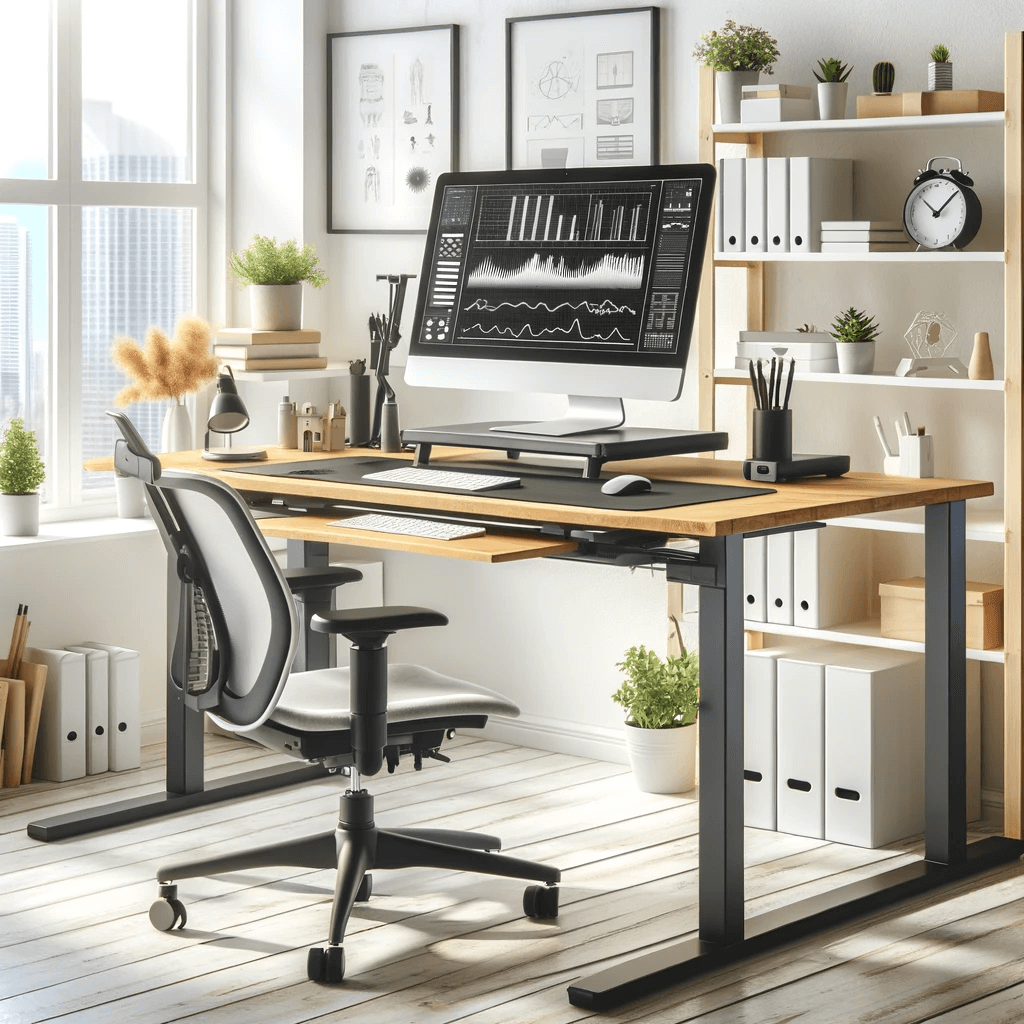In today’s fast-paced world, where much of our lives are spent interacting with technology and sitting at workstations, understanding the importance of ergonomics has never been more critical. Ergonomics, often regarded as the science of work, focuses on designing and arranging things people use so that they interact most efficiently and safely. This guide delves deep into the world of ergonomics, exploring its significance in various environments – from the bustling office to the comfort of your home.
Ergonomics isn’t just about finding the right office chair or keyboard; it’s about creating environments that support and improve our health, productivity, and overall well-being. The implications of ignoring ergonomic principles can range from chronic health issues to decreased productivity and satisfaction. Therefore, grasping the essence of why ergonomics is crucial is vital in today’s work culture, especially with the increasing trend towards remote work and hybrid work environments.
For additional insights into the evolving nature of work environments, particularly in remote settings, consider exploring the comprehensive study presented in the “2024 Guide for Well-being in Remote Work“.
Table of Contents

Understanding Ergonomics
What is Ergonomics?
Ergonomics, derived from the Greek words ‘ergon’ (work) and ‘nomos’ (laws), is the scientific discipline concerned with understanding human interactions with other elements of a system. It applies theory, principles, data, and methods to design in order to optimize human well-being and overall system performance. The inception of ergonomics can be traced back to the early 20th century, but it gained significant importance during World War II, where it was critical in improving safety and efficiency in war equipment design.
Ergonomics today goes beyond the workplace. It encompasses every aspect of our lives where interaction with tools, environments, and systems occurs. From the design of car controls to the layout of kitchen appliances, ergonomics plays a pivotal role in our daily lives.
Key Components of Ergonomics
Ergonomics can be divided into three main categories:
- Physical Ergonomics: This is the most well-known aspect, focusing on human anatomical, anthropometric, physiological, and biomechanical characteristics as they relate to physical activity. Key concerns include workstation design, posture, repetitive movements, work-related musculoskeletal disorders, and the use of machinery.
- Cognitive Ergonomics: This relates to mental processes, such as perception, memory, reasoning, and motor response, as they affect interactions among humans and other elements of a system. Relevant topics include mental workload, decision-making, skilled performance, human-computer interaction, human reliability, and work stress.
- Organizational Ergonomics: This involves optimizing sociotechnical systems, including their organizational structures, policies, and processes. It addresses topics like telework, flexible work hours, teamwork, job design, community ergonomics, and cooperative work.
Understanding these components highlights the comprehensive nature of ergonomics and its relevance in creating harmonious and efficient environments, both in the workplace and in our personal lives.

The Impact of Ergonomics on Health
Physical Health and Ergonomics
The physical aspect of ergonomics is crucial in maintaining and improving employee health and well-being. Poor ergonomic practices can lead to a range of musculoskeletal disorders (MSDs) such as carpal tunnel syndrome, tendonitis, and lower back injuries. These conditions often result from repetitive tasks, forceful exertions, vibrating tools, and awkward postures. According to the Bureau of Labor Statistics, MSDs account for about 33% of all worker injury and illness cases.
Ergonomically designed workspaces and tools help maintain proper posture, reduce unnecessary physical strain, and prevent long-term health problems. For example, an ergonomically designed chair supports the lower back’s natural curve, reducing the risk of back pain, one of the most common work-related health issues.
Mental Health Considerations
The impact of ergonomics isn’t limited to physical health; it also plays a significant role in mental well-being. A poorly designed workspace can lead to increased stress, frustration, and fatigue. Conversely, a well-designed, ergonomic environment can enhance cognitive performance, reduce mental strain, and improve overall job satisfaction.
A study published in the “International Journal of Industrial Ergonomics” found that ergonomic improvements not only decreased discomfort but also reduced stress and increased job satisfaction among office workers. This finding highlights the importance of ergonomic considerations in designing workspaces that are not only physically comfortable but also mentally conducive to well-being.

Ergonomics in the Workplace
Boosting Productivity and Efficiency
Ergonomic practices in the workplace play a pivotal role in enhancing employee productivity and efficiency. A study by the Health and Safety Executive (HSE) in the UK revealed that ergonomic interventions could lead to a 25% increase in productivity. By designing workstations that reduce unnecessary movement and allow for comfortable postures, employees can work more efficiently and with fewer errors.
For example, an ergonomic keyboard and mouse setup can reduce the strain on hands and wrists, leading to fewer breaks and disruptions. Similarly, an adjustable desk that allows employees to alternate between sitting and standing can reduce fatigue and maintain energy levels throughout the day.
Incorporating insights from resources like “5 Key Insights into Hybrid Remote Work” can further enhance the effectiveness of ergonomic practices, especially in hybrid and remote work environments.
Reducing Workplace Injuries
Ergonomic improvements are also essential in reducing workplace injuries. The Occupational Safety and Health Administration (OSHA) reports that work-related musculoskeletal disorders are among the most frequently reported causes of lost or restricted work time. Implementing ergonomic solutions like adjustable chairs, proper lighting, and ergonomic tools can significantly decrease the incidence of work-related injuries.
By analyzing the tasks, workspaces, and tools used in the workplace, employers can identify potential ergonomic risks and implement solutions to mitigate them. This not only helps in reducing the frequency of injuries but also in lowering the severity of injuries that do occur.

The Financial Implications of Ergonomics
Cost Savings from Ergonomic Solutions
The implementation of ergonomic practices in the workplace is not just beneficial for employee well-being; it also has significant financial benefits for organizations. Ergonomic improvements can lead to substantial cost savings by reducing the number of work-related injuries, which in turn decreases workers’ compensation claims and insurance costs.
A study by the Washington State Department of Labor and Industries found that for every $1 invested in ergonomic improvements, companies saw an average return of $17. This impressive return on investment is attributed to reduced absenteeism, lower healthcare costs, and increased productivity.
The Economic Impact of Ignoring Ergonomics
Ignoring ergonomic principles can have severe economic repercussions for businesses. The costs associated with work-related musculoskeletal disorders, including medical expenses, lost productivity, and compensation, are substantial. According to the U.S. Bureau of Labor Statistics, these disorders account for one-third of all worker injury and illness cases, with considerable financial implications.
Moreover, non-ergonomic work environments can lead to decreased employee morale and higher turnover rates, further adding to a company’s financial burdens. Investing in ergonomic solutions is not only a matter of employee health but also a strategic financial decision for long-term business sustainability.
Ergonomics in Daily Life
Ergonomics at Home
The principles of ergonomics are just as important in our homes as they are in the workplace. With the rise of remote work, creating an ergonomic home office has become crucial. Proper chair height, adequate equipment spacing, and good lighting can significantly reduce the risk of discomfort and injury. For instance, positioning your computer monitor at eye level helps avoid neck strain, and using a chair that supports your spine’s natural curve can prevent back pain.
In addition to the home office, ergonomic considerations in the kitchen, bedroom, and even while doing household chores can make daily activities more comfortable and less straining on the body. For more insights on achieving a balance between work and personal life in a remote work setting, explore “At Home But At Work: Achieving Remote Work-Life Balance in 2023“.
Ergonomics and Leisure Activities
Ergonomics also plays a vital role in leisure activities, including sports, hobbies, and gaming. Proper ergonomic practices can enhance performance, increase enjoyment, and prevent injuries in these activities. For example, in gaming, ergonomic chairs and controllers are designed to provide support and reduce strain during long gaming sessions. In sports, equipment like ergonomically designed bicycles and golf clubs can improve performance and reduce the risk of injury.
Understanding and applying ergonomic principles in all aspects of life, not just at work, can lead to a healthier, more comfortable, and more enjoyable lifestyle.

Advances in Ergonomic Design
Innovative Ergonomic Technologies
The field of ergonomics is continually evolving, with new technologies and designs emerging to enhance comfort and efficiency. Innovations such as adjustable sit-stand desks, ergonomic keyboards, and advanced office chairs with lumbar support and adjustable armrests are becoming increasingly popular in modern workplaces.
Advancements in wearable technology also offer exciting prospects. For example, exoskeletons are being developed to aid workers in manual handling tasks, reducing physical strain and the risk of injury. Virtual reality (VR) and augmented reality (AR) technologies are being used for ergonomic assessments and training, allowing for the simulation and analysis of work environments and tasks in a virtual space.
Case Studies of Successful Ergonomic Designs
Real-world examples highlight the effectiveness of ergonomic solutions. For instance, a case study by the Human Factors and Ergonomics Society showed how a company redesigned its packing station, leading to a 75% reduction in shoulder and back complaints among employees. Another example is the development of ergonomically designed surgical instruments, which has significantly reduced surgeon fatigue and improved precision in operations.
These case studies demonstrate that ergonomic interventions can lead to remarkable improvements in both health outcomes and operational efficiency.
Implementing Ergonomic Practices
How to Start with Ergonomics
Implementing ergonomic practices doesn’t have to be overwhelming. Starting with small, manageable changes can make a significant difference. Here are some steps to begin incorporating ergonomics into daily life:
- Self-Assessment: Evaluate your current workspace and identify areas that cause discomfort or strain. Tools like online ergonomic assessment checklists can be helpful.
- Adjustments: Make simple adjustments such as rearranging your desk, changing the chair height, or repositioning your computer monitor.
- Ergonomic Products: Consider investing in ergonomic products like chairs, keyboards, and mouse pads that provide better support and alignment.
- Regular Breaks: Incorporate short breaks into your routine to stretch and move around, reducing the risk of strain from prolonged sitting or repetitive tasks.
- Ergonomic Training: Educate yourself on basic ergonomic principles. Many online resources and tutorials can guide you on proper posture and equipment usage.
Professional Guidance on Ergonomics
For more complex situations or chronic discomfort, seeking professional advice is advisable. Ergonomic consultants or occupational therapists can provide personalized assessments and recommendations. They can help design a workspace that suits your specific needs, ensuring optimal comfort and efficiency.
Organizations should consider conducting ergonomic workshops and training sessions for employees. This not only educates the workforce on the importance of ergonomics but also demonstrates the organization’s commitment to employee well-being.
Implementing these ergonomic practices can lead to a healthier, more productive life, both at work and at home.
Conclusion
Understanding and applying ergonomic principles is crucial in today’s world, where much of our time is spent interacting with technology and engaging in repetitive tasks. Ergonomics is not just about comfort; it’s about optimizing our environments to enhance our health, efficiency, and overall well-being. By adopting ergonomic practices and making conscious adjustments to our daily routines, we can significantly improve our quality of life.
For further exploration and a deeper understanding of the impact of ergonomics, especially in remote work settings, the “2024 Guide for Well-being in Remote Work” is an excellent resource.
This comprehensive guide has walked you through the various facets of ergonomics, highlighting its importance not just in the workplace but in every aspect of our lives. Remember, the journey to a more ergonomic life starts with small steps – and the benefits are well worth the effort.





